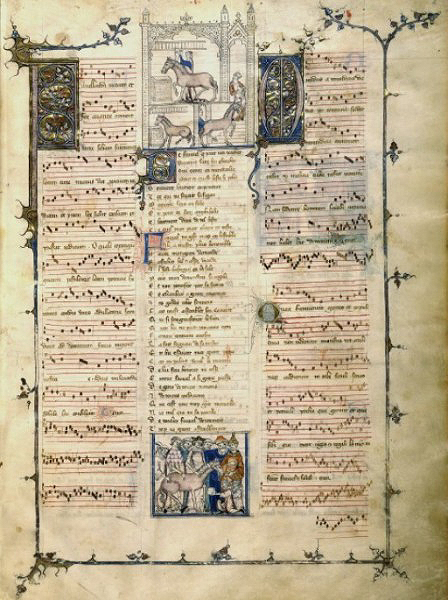
Ars nova
Ars nova (Latin for new art)[2] refers to a musical style which flourished in the Kingdom of France and its surroundings during the Late Middle Ages. More particularly, it refers to the period between the preparation of the Roman de Fauvel (1310s) and the death of composer Guillaume de Machaut in 1377. The term is sometimes used more generally to refer to all European polyphonic music of the fourteenth century. For instance, the term "Italian ars nova" is sometimes used to denote the music of Francesco Landini and his compatriots, although Trecento music is the more common term for the contemporary 14th-century music in Italy. The "ars" in "ars nova" can be read as "technique", or "style".[3] The term was first used in two musical treatises, titled Ars novae musicae (New Technique of Music) (c. 1320) by Johannes de Muris, and a collection of writings (c. 1322) attributed to Philippe de Vitry often simply called "Ars nova" today.[4] Musicologist Johannes Wolf first applied to the term as description of an entire era (as opposed to merely specific persons) in 1904.[2]
For other uses, see Ars nova (disambiguation).
The term ars nova is often used in juxtaposition to two other periodic terms, of which the first, ars antiqua, refers to the music of the immediately preceding age, usually extending back to take in the period of Notre Dame polyphony (from about 1170 to 1320). Roughly, then, ars antiqua refers to music of the thirteenth century, and the ars nova that of the fourteenth; many music histories use the terms in this more general sense.[2]
The period from the death of Machaut (1377) until the early fifteenth century, including the rhythmic innovations of the ars subtilior, is sometimes considered the end of, or late, ars nova but at other times an independent era in music.[2] Other musical periods and styles have at various times been called "new art." Johannes Tinctoris used the term to describe Dunstaple;[5] however, in modern historiographical usage, it is restricted entirely to the period described above.[2]
Versus ars antiqua[edit]
Stylistically, the music of the ars nova differed from the preceding era in several ways. Developments in notation allowed notes to be written with greater rhythmic independence, shunning the limitations of the rhythmic modes which prevailed in the thirteenth century; secular music acquired much of the polyphonic sophistication previously found only in sacred music; and new techniques and forms, such as isorhythm and the isorhythmic motet, became prevalent. The overall aesthetic effect of these changes was to create music of greater expressiveness and variety than had been the case in the thirteenth century.[6] Indeed, the sudden historical change which occurred, with its startling new degree of musical expressiveness, can be likened to the introduction of perspective in painting, and it is useful to consider that the changes to music in the period of the ars nova were contemporary with the great early Renaissance revolutions in painting and literature.[7]
The most famous practitioner of the new musical style was Guillaume de Machaut, who also had a distinguished career as a canon at Reims Cathedral and as a poet. The ars-nova style is evident in his considerable body of motets, lais, virelais, rondeaux and ballades.[8]
Towards the end of the fourteenth century, a new stylistic school of composers and poets centered in Avignon in southern France developed; the highly mannered style of this period is often called the ars subtilior, although some scholars have chosen to consider it a late development of the ars nova rather than separating it into a separate school. This strange but interesting repertory of music, limited in geographical distribution (southern France, Aragon and later Cyprus), and clearly intended for performance by specialists for an audience of connoisseurs, is like an "end note" to the entire Middle Ages.[9]